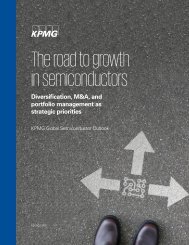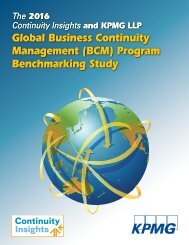Revenue for Telecoms
2cdncba
2cdncba
Create successful ePaper yourself
Turn your PDF publications into a flip-book with our unique Google optimized e-Paper software.
122 | <strong>Revenue</strong> <strong>for</strong> <strong>Telecoms</strong> – Issues In-Depth<br />
| 6 Step 5: Recognize revenue when or as the entity satisfies a per<strong>for</strong>mance obligation<br />
606-10-55-18<br />
[IFRS 15.B16]<br />
606-10-25-36 – 25-37<br />
[IFRS 15.44–45]<br />
As a practical expedient, if an entity has a right to invoice a customer at an amount<br />
that corresponds directly with its per<strong>for</strong>mance to date, then it can recognize revenue<br />
at that amount. For example, in a services contract an entity may have the right<br />
to bill a fixed amount <strong>for</strong> each unit of service provided or <strong>for</strong> each time period (e.g.<br />
each month).<br />
An entity recognizes revenue over time only if it can reasonably measure its progress<br />
toward complete satisfaction of the per<strong>for</strong>mance obligation. However, if the entity<br />
cannot reasonably measure the outcome but expects to recover the costs incurred in<br />
satisfying the per<strong>for</strong>mance obligation, then it recognizes revenue to the extent of the<br />
costs incurred.<br />
The new standard contains guidance on measuring and adjusting measures of<br />
progress when input methods are used – e.g. uninstalled materials. See 5.5.3.3 in<br />
Issues In-Depth, Edition 2016 <strong>for</strong> further in<strong>for</strong>mation.<br />
Example 48 – Monthly prepaid wireless contract<br />
Telco M enters into a monthly prepaid contract with wireless Customer B <strong>for</strong><br />
200 minutes per month of voice services. Customer B pays 30 per month in<br />
advance. Customer B can use the minutes at any time during the month. Once<br />
the 200 minutes are used, the handset remains connected to the network and<br />
can accept calls. That is, incoming calls are not included in the 200 minutes<br />
per month.<br />
Telco M first concludes that Customer B simultaneously receives and consumes<br />
the benefits from the services as it is provided and thus the per<strong>for</strong>mance<br />
obligation is satisfied over time. Furthermore, Telco M determines that the<br />
nature of its promise is to provide network services to Customer B throughout<br />
the month because incoming calls are not included in the 200 minutes.<br />
Consequently, the number of minutes used does not appear to appropriately<br />
depict the satisfaction of that promise. Instead, the more appropriate measure<br />
of progress appears to be time elapsed. Telco M there<strong>for</strong>e recognizes revenue of<br />
30 evenly throughout the month.<br />
Example 49 – Wireless service contract with rollover minutes feature<br />
Telco N enters into a two-year wireless contract with Customer C <strong>for</strong> prepaid<br />
voice services. The voice plan allows the Customer C to use 600 minutes each<br />
month <strong>for</strong> incoming and outgoing calls. After the 600 minutes are used, the<br />
handset can no longer be used to make or receive calls during that month. If<br />
Customer C does not use all of the minutes, then Customer C is able to roll over<br />
the unused minutes to the subsequent month. For the purposes of this example,<br />
breakage is ignored.<br />
Home<br />
© 2016 KPMG LLP, a Delaware limited liability partnership and the US member firm of the KPMG network of<br />
independent member firms affiliated with KPMG International Cooperative, a Swiss entity. All rights reserved.<br />
© 2016 KPMG IFRG Limited, a UK company, limited by guarantee. All rights reserved.







